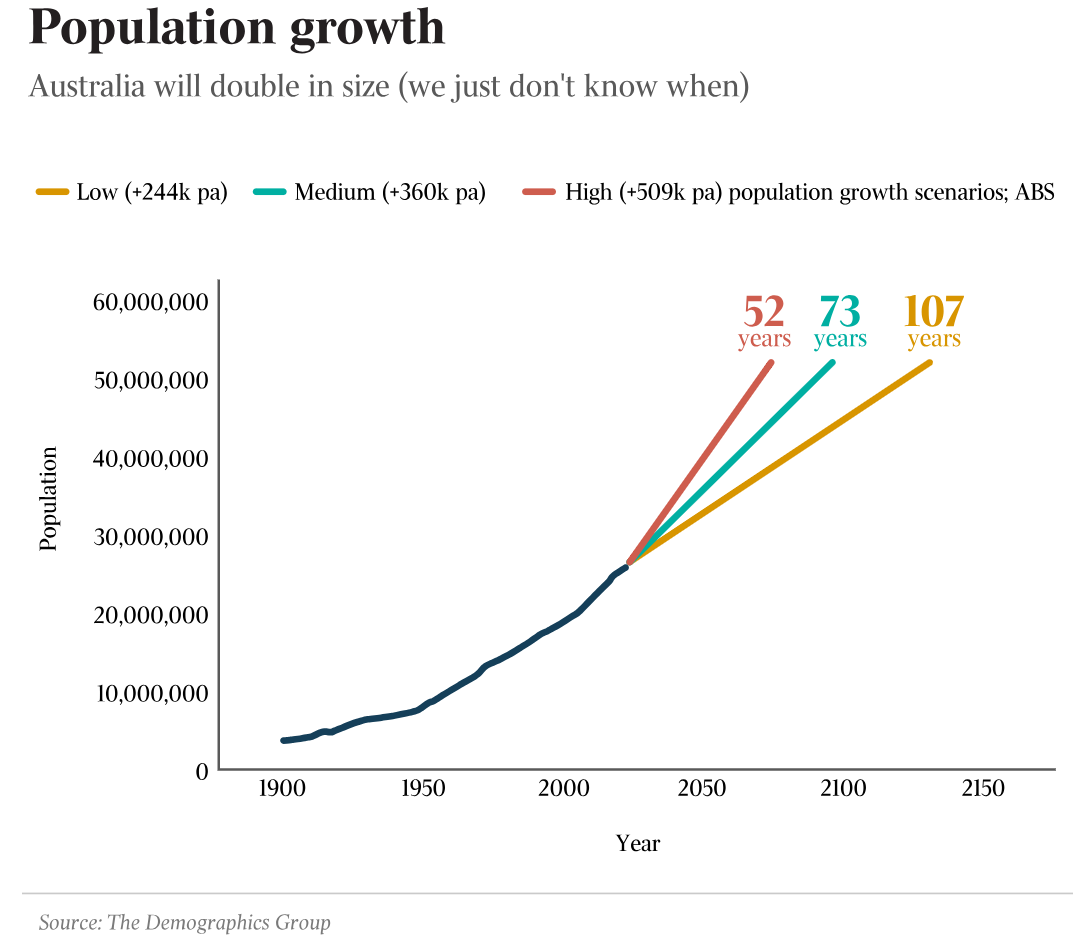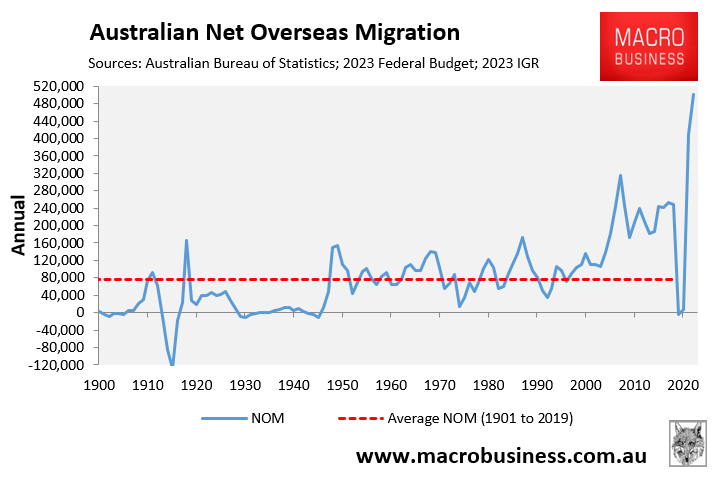Simon Kuestenmacher from The Demographics Group believes that Australia’s population will double in size in just over 50 years, based on the ABS’ latest population projections:

“The most bearish scenario sees our population doubling by 2129, the median scenario by 2095, and the most bullish scenario sees Australia at 52 million people by 2074. I would argue that Australia realistically might double in 66 years”.
“I would argue that, looking a few decades into the future, the most plausible migration scenario for Australia is a high one”.
Kuestenmacher also described Australia’s economic growth model as follows:
“Our simple Australian business model relies on us making money by selling mining and agricultural products to the world, while bringing foreigners into the country who are willing to pay for university degrees and who consume tourism offerings”.
“Businesses in these sectors need people in Australia drilling, harvesting, educating, and entertaining. These jobs can’t possibly be done outside of the country.
“For the Australian business model to work, we need workers in the country. Without migration, we are running out of workers fast”.
This “business model” all but guarantees falling living standards for Australians.
First, if this model “relies on us making money by selling mining and agricultural products to the world”, where is the sense in diluting the nation’s mineral wealth among larger numbers of people?
Australia is unique in that it pays its way in the world mostly via the sale of its fixed mineral endowment.
Therefore, importing millions of people via strong net overseas migration will necessarily spread these mineral riches among more people, resulting in lower wealth per person (other things being equal).
This brings us to the second part of Australia’s growth model, which relies on funnelling people into low-productivity people-servicing industries in education, hospitality, and the like, while focusing the nation’s productive effort into infrastructure and housing in a bid to keep pace with rapacious population growth.
Australia’s population has expanded by 7.5 million people (40%) this century alone via mass immigration.
However, business investment, infrastructure investment, and housing has failed to keep pace:

In turn, capital stock per worker has shrunk, leading to “capital shallowing” and declining productivity:

Source: Gerard Minack
Congestion costs have also soared as infrastructure has become crush-loaded, further reducing productivity.
As noted by economist Gerard Minack last week:
“Australia’s economic performance in the decade before the pandemic was, on many measures, the worst in 60 years”.
“Per capita GDP growth was low, productivity growth tepid, real wages were stagnant, and housing increasingly unaffordable. There were many reasons for the mess, but the most important was a giant capital-to-labour switch: Australia relied on increasing labour supply, rather than increasing investment, to drive growth”.
“Australia’s population-led growth model was a demonstrable failure in the 15 years prior to the pandemic. Remarkably, the country now seems to be doubling down on the same strategy. The result, unsurprisingly, is likely to be more of the same”.
For a resource-rich nation like Australia, you literally could not devise a dumber growth model.
Heck, even Kuestenmacher admits that the swelling of Sydney and Melbourne above their efficient size has killed living standards:
“For decades, we ran a migration nation without linking our national housing and migration policies. A rather ridiculous oversight if you ask me”…
“Melbourne and Sydney both stopped functioning seamlessly in their current set-up (one main CBD, low population density, huge urban sprawl) at around 4 million residents”.
Yet, Kuestenmacher still supports the failed ‘Big Australia’ growth model, despite its epic failure.
When you are in an economic hole, Simon Kuestenmacher, stop digging.

Repeating the same failed immigration policy of the recent past and expecting a different result is the definition of insanity.

